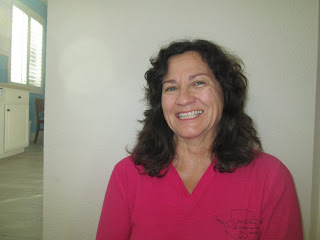by Baxter
 |
| Cloud Study by John Constable |
During a recent Yoga for Healthy Aging weekend workshop, one of the participants, yoga teacher Debbie Cabusas, alluded to some big changes in her life that occurred when she started doing pranayama. Intrigued, I decided to interview her to learn more.
Baxter: Tell me a bit about yourself and what was happening before you started doing pranayama regularly.
Debbie: I just turned 60 and have practiced yoga for the last 36 years off and on, but pretty consistently for the last 12 years. I have studied with Sandy Carmellini the last 8 years. I have taught yoga for the last 6 years, and am a registered yoga teacher at the E-RYT 200 and a RYT500 levels. I have had a meditation practice for about two-and-a-half years. It was definitely a “practice “and things were going pretty dismally, as far as my focus went. I was also heavier than I think is healthy for me, with my weight before this shift in my practice at 200 lbs. I consider myself a sugar addict and my previous attempt to lose weight just didn’t work. I also have had high blood pressure for 25 years, controlled on medication, and a cranky neck for 35 years.
Baxter: How did you decide to make pranayama a priority?
Debbie: In February of 2016, Sandy offered a six-day intensive for pranayama and meditation. I figured it might help my meditation and that I needed to learn more pranayama, as my knowledge was pretty limited, and I had no pranayama practice to speak of.
A funny thing happened to me about two or three days into the immersion: I noticed my sugar cravings were pretty much gone. As I continued to regularly practice pranayama, I continued to have a lack of almost all cravings, and I began to lose weight. It’s not that the only thing I did was pranayama. I did also cleanses/detoxes, controlled my eating, and upped my exercise to include three days a week of cycling. It was hard work. But what made the difference was the lack of almost all cravings! I can attribute that to my pranayama practice.
Baxter: Did the addition of pranayama to your yoga practices have any other consequences?
Debbie: Oh, yes! I have reaped so many benefits for my pranayama practice. Here is the list of what I have observed. It is hard to put them order, but the 1st is what I believe is number 1.
1. I am happier, and more accepting of and compassionate with myself and others. I appreciate my life.
2. I lost 30 pounds. Now weigh 170.2 lbs. Everything is easier now.
3. My lung capacity has increased, maybe as much as 35-50%. I used to have to stop and catch my breath 3 -4 times on a 2-mile upward hike; now I may not need to stop at all. I actually ran (not a runner!) at Bryce Canyon (altitude of 8.5k feet). This has also allowed me to cycle with the cycle club. When biking hills, my heart rate only goes up to 135ish. I now cycle ~12 miles 2x weekly on my own, and 20 miles on the weekend with the club.
4. I am a much calmer person.
5. My blood pressure is down enough for my doctor to cut my dose in half (a dose I have been on for the last 6 years). He was so happy to see that I had done the work. You would appreciate this as a doctor. You tell your patients this is what will be good for you and we never do it. Both my father and his mother died from strokes that they had at 61 years old.
6. My resting heart rate is down in the low 40s.
7. Last, but certainly not least, my chronic neck pain is much better given the good stretch the back of my neck gets in pranayama, as I use Jalandhara Bandha in each practice.
Baxter: Wow, that is quite a shift on so many levels. It is certainly reflects the potential of pranayama, and why we at YFHA recommend pranayama as a tool for stress management, pain management, improving digestion and so many other things. Thank you for taking the time to share your experiences with us, Debbie!

Debbie Cabusas, RYT500, lives and teaches yoga in Brentwood, CA. Debbie is a Yoga Alliance 500 Hour Registered Yoga Teacher (RYT-500) with an additional 300+ hours of training. She is also a Yoga Alliance Experienced Registered Yoga Teacher (E-RYT 200) with 1300+ hours of experience teaching a variety of classes and workshops. Debbie’s classes reflect both her broad experience and her love of learning and teaching. See www.deltalotusyoga.com or contact her at ddebbie@deltalotusyoga.com.
Follow Yoga for Healthy Aging on Facebook ° To order Yoga for Healthy Aging: A Guide to Lifelong Well-Being, go to Amazon, Shambhala, Indie Bound or your local bookstore.


Curious as to what the pranayama practice is — lots of results but no details of the practice here. Is it practice with asana? Is it separate — or both? How long is it if separate and what does it consist of? I cannot imagine getting through teacher training and years of practice without pranayama, so I wonder what makes this "focus" different.
Pranayama is yogic breath practices (as opposed to simple breath awareness). It is separate from asana, and usually practiced in a seated or recline position like meditation. It is also the fourth branch of yoga in the Yoga Sutras and elsewhere. If you have gone through teacher training without experiencing pranayama or reading the Yoga Sutras, you've missed out on a lot of important information about yoga! So I recommend you take some workshops on both topics to round out your knowledge.
However, I do agree this post would have been better if it explained what pranayama is and added some examples of what Debbie did, and I may try to revise it.
Thanks for your comment!
Also, if you search on pranayama on our blog, you'll be able to learn quite a bit more!
I was not clear. I know what pranayama is and it is part of my practice. I would say when I hit the mat, within the first three minutes of breath work, my body settles. I do pranayama as part of my asana practice as well as before or at the end of asana. However, I do not set aside a separate time. I work with different breaths –maybe to bring balance, calm or energy — but perhaps with less intention than I might. Given all these fabulous results from some kind of change,she does not describe her changed practice at all — except with that word focus. ( I suspect her earlier practice was a bit like mine — that she did pranayama but with less intention — and with less time? ) What did she add — did she systematically work on a new — or less conventional breath each week? Did she regularly add kapalbhati breath or dirga pranayama or brahmari breath? I cannot imagine doing yoga without pranayama. PS — love this blog — just want more specifics from this post.
Thanks for your comment. Before having a dedicated pranayama practice, I also did some minor pranayama during my Asana practice. I now start each day with 20 minutes of dedicated pranayama, in a reclined, chest lifted, chin dropped in Jalandhara bandha, position. I follow that by 20 minutes of seated meditation.
I have received multiple inquires about details of my practice, so here goes.
I have been practicing pranayama for 9 months now. I practice pranayama for 20 minutes followed by 20 minutes of meditation.
I was initially doing five minutes of Ujjaii I (breath observation), then 5 minutes of a variation of Ujjaii III (sideways breathing into the sideribs), and then 10 minutes of Viloma III breathing (combination of Viloma I – 3 part inhale and Viloma II – 3 part exhale).
I then switched to 10 minutes of Ujjaii III followed by 10 minutes of Viloma III breathing.
Now I am doing 10 minutes of Ujjaii III followed by 10 minutes of inhale 6, hold 16, exhale 16 (I am not sure of the name).
Ok, I was feeling a little brain dead. My last 10 minutes are a variation of
Nadi Sodhana (Alternate Nostril Breathing)
Congratulations on your positive changes Debbie! Sounds like you did a great job of combining not just your enhanced breathing practice and meditation but also upping your cardio with cycling, clean eating, resulting in a 30 pound weight loss is fantastic I believe from personal experience the combination of all strategies magnifies and enhances the positive results. Synergy. Sugar cravings are real and hard to fight. When I virtually eliminated sugar, meat and processed foods from my diet and added cycling 50-60 miles weekly to my regular yoga practice I begin to feel stronger then ever. My journey is similar to yours with a loss of 60 pounds staring about eight years ago. I really encourage this wholistic approach for my own yoga students also and the + results have been encouraging for many.
Thanks for updating. Very helpful.